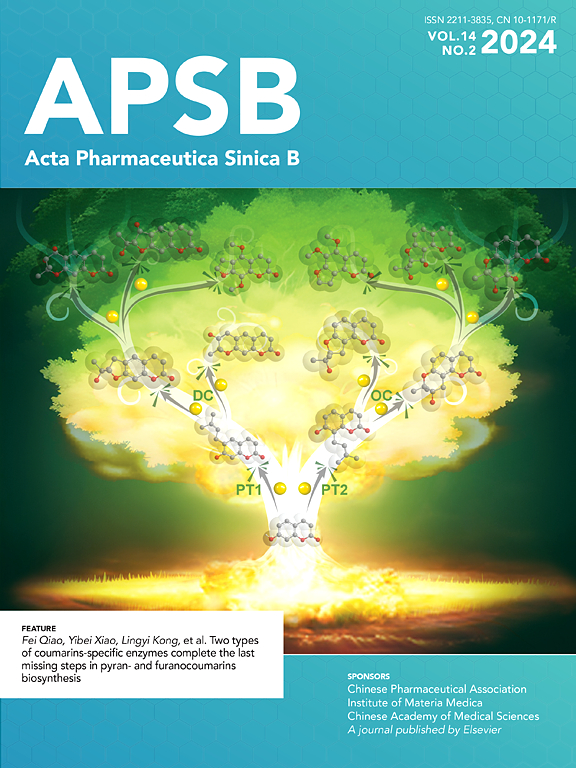通过NIR-II荧光成像快速发现药物引入的多器官功能障碍
IF 14.6
1区 医学
Q1 PHARMACOLOGY & PHARMACY
引用次数: 0
摘要
准确、快速地监测多器官功能障碍对药物开发至关重要。传统的方法,如病理分析,往往是费时和低效的。在这里,我们开发了一种多路近红外窗口二(NIR-II)荧光生物成像方法,可以实时、快速和定量地评估多器官功能障碍。鉴于现有探针不能完全满足要求,我们合成了一系列具有不同吸收和发射波长的NIR-II半花青碱染料(hd)。通过修改这些染料,我们实现了肝脏、肾脏、胃和肠的高空间和时间分辨率成像。该方法被进一步应用于研究顺铂引起的疾病,顺铂是一种已知会导致胃排空问题以及肝脏和肾脏损伤的药物。通过监测染料在这些器官中的代谢率,我们准确地量化了多器官功能障碍,这也得到了金标准病理分析的证实。此外,我们评估了五种马兜铃酸(AAs)对多器官功能障碍的影响。我们首次发现AA-I和AA-II可能导致胃排空障碍,并通过转录组学分析进一步验证了这一点。我们的研究提出了一种同时监测多器官功能障碍的新方法,可以显著提高对药物副作用的评估。本文章由计算机程序翻译,如有差异,请以英文原文为准。

Rapid discovery of drug-introduced multiple organ dysfunction via NIR-II fluorescent imaging
The precise and rapid monitoring of multiple organ dysfunction is crucial in drug discovery. Traditional methods, such as pathological analysis, are often time-consuming and inefficient. Here, we developed a multiplexed near-infrared window two (NIR-II) fluorescent bioimaging method that allows for real-time, rapid, and quantitative assessment of multiple organ dysfunctions. Given that existing probes did not fully meet requirements, we synthesized a range of NIR-II hemicyanine dyes (HDs) with varying absorption and emission wavelengths. By modifying these dyes, we achieved high spatial and temporal resolution imaging of the liver, kidneys, stomach, and intestines. This method was further applied to investigate disorders induced by cisplatin, a drug known to cause gastric emptying issues along with liver and kidney injuries. By monitoring the metabolic rate of the dyes in these organs, we accurately quantified multi-organ dysfunction, which was also confirmed by gold-standard pathological analysis. Additionally, we evaluated the effects of five aristolochic acids (AAs) on multiple organ dysfunction. For the first time, we identified that AA-I and AA-II could cause gastric emptying disorders, which was further validated through transcriptomics analysis. Our study introduces a novel approach for the simultaneous monitoring of multi-organ dysfunction, which may significantly enhance the evaluation of drug side effects.
求助全文
通过发布文献求助,成功后即可免费获取论文全文。
去求助
来源期刊

Acta Pharmaceutica Sinica. B
Pharmacology, Toxicology and Pharmaceutics-General Pharmacology, Toxicology and Pharmaceutics
CiteScore
22.40
自引率
5.50%
发文量
1051
审稿时长
19 weeks
期刊介绍:
The Journal of the Institute of Materia Medica, Chinese Academy of Medical Sciences, and the Chinese Pharmaceutical Association oversees the peer review process for Acta Pharmaceutica Sinica. B (APSB).
Published monthly in English, APSB is dedicated to disseminating significant original research articles, rapid communications, and high-quality reviews that highlight recent advances across various pharmaceutical sciences domains. These encompass pharmacology, pharmaceutics, medicinal chemistry, natural products, pharmacognosy, pharmaceutical analysis, and pharmacokinetics.
A part of the Acta Pharmaceutica Sinica series, established in 1953 and indexed in prominent databases like Chemical Abstracts, Index Medicus, SciFinder Scholar, Biological Abstracts, International Pharmaceutical Abstracts, Cambridge Scientific Abstracts, and Current Bibliography on Science and Technology, APSB is sponsored by the Institute of Materia Medica, Chinese Academy of Medical Sciences, and the Chinese Pharmaceutical Association. Its production and hosting are facilitated by Elsevier B.V. This collaborative effort ensures APSB's commitment to delivering valuable contributions to the pharmaceutical sciences community.
 求助内容:
求助内容: 应助结果提醒方式:
应助结果提醒方式:


